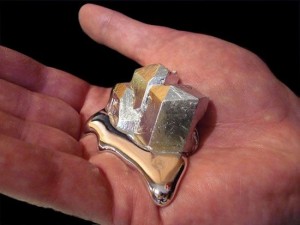Remember those liquid metal Terminators from the Arnold Schwarzenegger movies? What if I told you that kind of material isn’t just the fruit of someone’s sci-fi imagination, but a real metal? It’s called Gallium and it has some pretty cool properties.
So what makes gallium so special? Well, first of all, the brittle metal has a melting point of just 29.76 °C (85.57 °F), so if you hold it in your hand long enough it will become liquid. That alone is pretty cool, but this rare metal has a few other amazing properties. For example, it “attacks” other metals, like aluminum.
As you’re about to see in one of the videos below, just a drop of liquid gallium weakens the structure of a Coke can to the point where it can be pierced with the slight press of the thumb. Gallium infiltrates the aluminum structure, compromising its integrity and making the can feel like tin foil instead of metal. Another interesting experiment involving gallium is called the “beating heart”, in which the amazing element is made to look like an alien life form. When submerged in sulfuric acid and a dichromate solution, gallium looks like an organic beating heart, due to the gallium sulfate which increases surface tension.
The existence of gallium was predicted by Dmitri Mendeleev, father of the Periodic Table of Elements, in 1871. Although it hadn’t yet been discovered, the Russian chemist also accurately predicted some of its key properties, like the density and low melting point. But it was French chemist Paul Emile Lecoq de Boisbaudran who actually discovered the rare element in 1875, while examining a sphalerite sample.
From that point on, it was used in high-temperature thermometric applications, and in the preparation of alloys with special properties of stability and ease of melting. Today, gallium is mainly used in the semiconductor industry, and can be found in many of the gadgets and appliances we use every day.
Free form gallium doesn’t exist in nature, but it is extracted as a trace component in bauxite and to a small extent from sphalerite. The The United States Geological Survey estimates gallium reserves to exceed 1 million, and you can even find it for sale online, if you want to stage your own experiments. You should be careful with it though, because while metallic gallium is believed to be non-toxic the data is currently inconclusive, and some sources claim prolonged exposure can cause skin conditions like dermatitis. Injected in high amounts it has also resulted in renal toxicity in animals.





